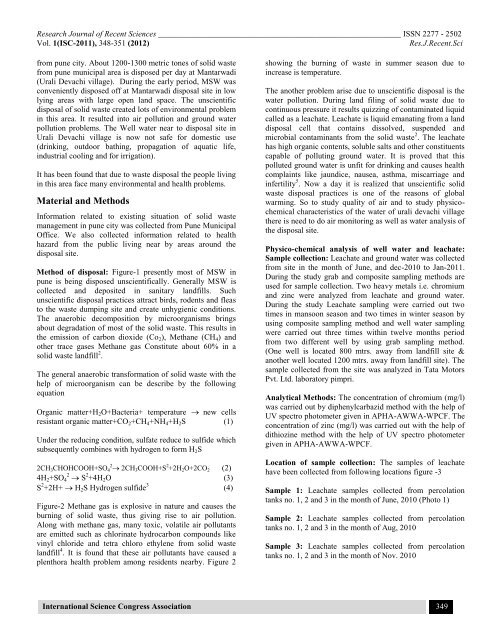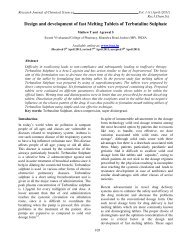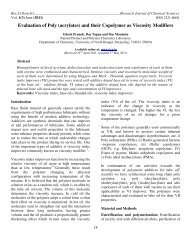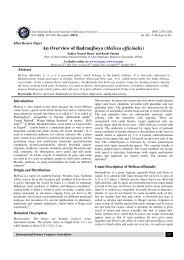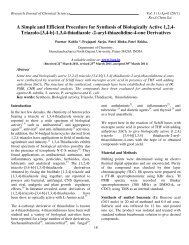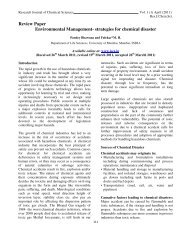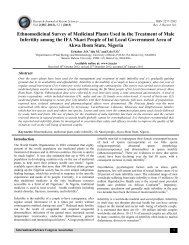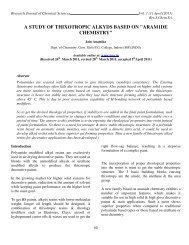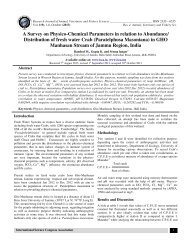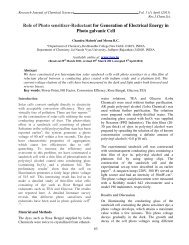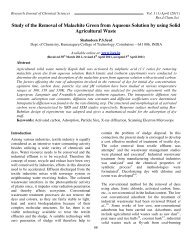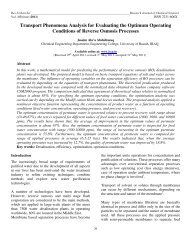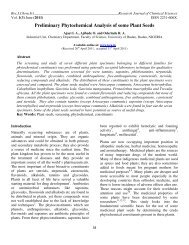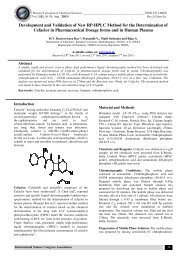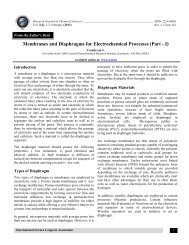Existing Situation of Solid Waste Management in Pune City ... - ISCA
Existing Situation of Solid Waste Management in Pune City ... - ISCA
Existing Situation of Solid Waste Management in Pune City ... - ISCA
You also want an ePaper? Increase the reach of your titles
YUMPU automatically turns print PDFs into web optimized ePapers that Google loves.
Research Journal <strong>of</strong> Recent Sciences ____________________________________________________________ ISSN 2277 - 2502<br />
Vol. 1(ISC-2011), 348-351 (2012) Res.J.Recent.Sci<br />
from pune city. About 1200-1300 metric tones <strong>of</strong> solid waste<br />
from pune municipal area is disposed per day at Mantarwadi<br />
(Urali Devachi village). Dur<strong>in</strong>g the early period, MSW was<br />
conveniently disposed <strong>of</strong>f at Mantarwadi disposal site <strong>in</strong> low<br />
ly<strong>in</strong>g areas with large open land space. The unscientific<br />
disposal <strong>of</strong> solid waste created lots <strong>of</strong> environmental problem<br />
<strong>in</strong> this area. It resulted <strong>in</strong>to air pollution and ground water<br />
pollution problems. The Well water near to disposal site <strong>in</strong><br />
Urali Devachi village is now not safe for domestic use<br />
(dr<strong>in</strong>k<strong>in</strong>g, outdoor bath<strong>in</strong>g, propagation <strong>of</strong> aquatic life,<br />
<strong>in</strong>dustrial cool<strong>in</strong>g and for irrigation).<br />
It has been found that due to waste disposal the people liv<strong>in</strong>g<br />
<strong>in</strong> this area face many environmental and health problems.<br />
Material and Methods<br />
Information related to exist<strong>in</strong>g situation <strong>of</strong> solid waste<br />
management <strong>in</strong> pune city was collected from <strong>Pune</strong> Municipal<br />
Office. We also collected <strong>in</strong>formation related to health<br />
hazard from the public liv<strong>in</strong>g near by areas around the<br />
disposal site.<br />
Method <strong>of</strong> disposal: Figure-1 presently most <strong>of</strong> MSW <strong>in</strong><br />
pune is be<strong>in</strong>g disposed unscientifically. Generally MSW is<br />
collected and deposited <strong>in</strong> sanitary landfills. Such<br />
unscientific disposal practices attract birds, rodents and fleas<br />
to the waste dump<strong>in</strong>g site and create unhygienic conditions.<br />
The anaerobic decomposition by microorganisms br<strong>in</strong>gs<br />
about degradation <strong>of</strong> most <strong>of</strong> the solid waste. This results <strong>in</strong><br />
the emission <strong>of</strong> carbon dioxide (Co2), Methane (CH4) and<br />
other trace gases Methane gas Constitute about 60% <strong>in</strong> a<br />
solid waste landfill 2 .<br />
The general anaerobic transformation <strong>of</strong> solid waste with the<br />
help <strong>of</strong> microorganism can be describe by the follow<strong>in</strong>g<br />
equation<br />
Organic matter+H2O+Bacteria+ temperature new cells<br />
resistant organic matter+CO2+CH4+NH4+H2S (1)<br />
Under the reduc<strong>in</strong>g condition, sulfate reduce to sulfide which<br />
subsequently comb<strong>in</strong>es with hydrogen to form H2S<br />
2CH 3CHOHCOOH+SO 4 2 CH3COOH+S 2 +2H 2O+2CO 2 (2)<br />
4H2+SO4 2 S 2 +4H2O (3)<br />
S 2 +2H+ H2S Hydrogen sulfide 3 (4)<br />
Figure-2 Methane gas is explosive <strong>in</strong> nature and causes the<br />
burn<strong>in</strong>g <strong>of</strong> solid waste, thus giv<strong>in</strong>g rise to air pollution.<br />
Along with methane gas, many toxic, volatile air pollutants<br />
are emitted such as chlor<strong>in</strong>ate hydrocarbon compounds like<br />
v<strong>in</strong>yl chloride and tetra chloro ethylene from solid waste<br />
landfill 4 . It is found that these air pollutants have caused a<br />
plenthora health problem among residents nearby. Figure 2<br />
show<strong>in</strong>g the burn<strong>in</strong>g <strong>of</strong> waste <strong>in</strong> summer season due to<br />
<strong>in</strong>crease is temperature.<br />
The another problem arise due to unscientific disposal is the<br />
water pollution. Dur<strong>in</strong>g land fil<strong>in</strong>g <strong>of</strong> solid waste due to<br />
cont<strong>in</strong>uous pressure it results quizz<strong>in</strong>g <strong>of</strong> contam<strong>in</strong>ated liquid<br />
called as a leachate. Leachate is liquid emanat<strong>in</strong>g from a land<br />
disposal cell that conta<strong>in</strong>s dissolved, suspended and<br />
microbial contam<strong>in</strong>ants from the solid waste 2 . The leachate<br />
has high organic contents, soluble salts and other constituents<br />
capable <strong>of</strong> pollut<strong>in</strong>g ground water. It is proved that this<br />
polluted ground water is unfit for dr<strong>in</strong>k<strong>in</strong>g and causes health<br />
compla<strong>in</strong>ts like jaundice, nausea, asthma, miscarriage and<br />
<strong>in</strong>fertility 5 . Now a day it is realized that unscientific solid<br />
waste disposal practices is one <strong>of</strong> the reasons <strong>of</strong> global<br />
warm<strong>in</strong>g. So to study quality <strong>of</strong> air and to study physicochemical<br />
characteristics <strong>of</strong> the water <strong>of</strong> urali devachi village<br />
there is need to do air monitor<strong>in</strong>g as well as water analysis <strong>of</strong><br />
the disposal site.<br />
Physico-chemical analysis <strong>of</strong> well water and leachate:<br />
Sample collection: Leachate and ground water was collected<br />
from site <strong>in</strong> the month <strong>of</strong> June, and dec-2010 to Jan-2011.<br />
Dur<strong>in</strong>g the study grab and composite sampl<strong>in</strong>g methods are<br />
used for sample collection. Two heavy metals i.e. chromium<br />
and z<strong>in</strong>c were analyzed from leachate and ground water.<br />
Dur<strong>in</strong>g the study Leachate sampl<strong>in</strong>g were carried out two<br />
times <strong>in</strong> mansoon season and two times <strong>in</strong> w<strong>in</strong>ter season by<br />
us<strong>in</strong>g composite sampl<strong>in</strong>g method and well water sampl<strong>in</strong>g<br />
were carried out three times with<strong>in</strong> twelve months period<br />
from two different well by us<strong>in</strong>g grab sampl<strong>in</strong>g method.<br />
(One well is located 800 mtrs. away from landfill site &<br />
another well located 1200 mtrs. away from landfill site). The<br />
sample collected from the site was analyzed <strong>in</strong> Tata Motors<br />
Pvt. Ltd. laboratory pimpri.<br />
Analytical Methods: The concentration <strong>of</strong> chromium (mg/l)<br />
was carried out by diphenylcarbazid method with the help <strong>of</strong><br />
UV spectro photometer given <strong>in</strong> APHA-AWWA-WPCF. The<br />
concentration <strong>of</strong> z<strong>in</strong>c (mg/l) was carried out with the help <strong>of</strong><br />
dithioz<strong>in</strong>e method with the help <strong>of</strong> UV spectro photometer<br />
given <strong>in</strong> APHA-AWWA-WPCF.<br />
Location <strong>of</strong> sample collection: The samples <strong>of</strong> leachate<br />
have been collected from follow<strong>in</strong>g locations figure -3<br />
Sample 1: Leachate samples collected from percolation<br />
tanks no. 1, 2 and 3 <strong>in</strong> the month <strong>of</strong> June, 2010 (Photo 1)<br />
Sample 2: Leachate samples collected from percolation<br />
tanks no. 1, 2 and 3 <strong>in</strong> the month <strong>of</strong> Aug, 2010<br />
Sample 3: Leachate samples collected from percolation<br />
tanks no. 1, 2 and 3 <strong>in</strong> the month <strong>of</strong> Nov. 2010<br />
International Science Congress Association 349


